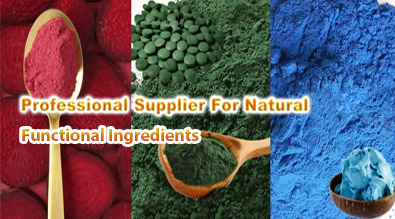Lutein E161b vs. Zeaxanthin: Key Differences
When it comes to eye health and overall wellness, two powerful carotenoids often take center stage: Lutein E161(b) and Zeaxanthin. While these compounds share similarities, they also have distinct characteristics and benefits. This comprehensive guide will explore the key differences between Lutein E161b and Zeaxanthin, their unique roles in eye health, and how they contribute to overall well-being.

Benefits of Lutein E161(b) for Eye Health
Lutein E161b, commonly referred to as simply "lutein," is a xanthophyll carotenoid that plays a crucial role in maintaining optimal eye health. This powerful antioxidant is found naturally in the macula, the central part of the retina responsible for sharp, detailed vision.
Protection Against Blue Light
One of the primary benefits of Lutein E161b is its ability to filter harmful blue light. In our digital age, we're constantly exposed to blue light emitted by electronic devices, which can lead to eye strain and potential long-term damage. Lutein acts as a natural blue light filter, helping to protect the delicate structures of the eye from oxidative stress and potential damage.
Macular Pigment Optical Density
Lutein E161b is a key component of the macular pigment, which is crucial for maintaining visual acuity and contrast sensitivity. By increasing macular pigment optical density (MPOD), lutein helps enhance visual performance and may reduce the risk of age-related macular degeneration (AMD), a leading cause of vision loss in older adults.
Antioxidant Properties
As a potent antioxidant, Lutein E161(b) neutralizes free radicals in the eye, reducing oxidative stress and inflammation. This protective action may help prevent or slow the progression of various eye conditions, including cataracts and diabetic retinopathy.

Lutein E161(b) vs. Zeaxanthin: Which is More Effective?
While Lutein E161b and Zeaxanthin are often mentioned together, they have distinct characteristics and roles in eye health. Understanding these differences can help determine which may be more effective for specific eye health concerns.
Structural Differences
Lutein (E161b) and zeaxanthin are isomers, meaning they share the same chemical formula but differ in their structural arrangement. This slight variation influences their roles in the body, particularly in how they function and where they accumulate within the eye. These differences are important in supporting eye health and protecting against damage caused by oxidative stress and light exposure.
Distribution in the Eye
Lutein (E161b) is found in greater concentrations in the peripheral retina, whereas zeaxanthin is more abundant in the central macula. This distinct distribution indicates that each compound may play specialized roles in different regions of the eye. Lutein may help protect the peripheral retina from light-induced damage, while zeaxanthin, concentrated in the macula, likely supports central vision and provides enhanced protection against oxidative stress and harmful blue light.
Absorption and Bioavailability
Studies have shown that lutein (E161b) and zeaxanthin have varying absorption rates and bioavailability in the body. Some research indicates that zeaxanthin may be more easily absorbed and utilized, potentially making it more effective in certain aspects of eye health. This difference in bioavailability may influence how each compound supports vision and protects the eye from oxidative damage and harmful light, suggesting that zeaxanthin could play a more prominent role in maintaining eye function.
Synergistic Effects
When comparing the effectiveness of lutein (E161b) and zeaxanthin, it's important to recognize that these compounds often work together synergistically. Many eye health supplements include both carotenoids to offer comprehensive protection and enhance overall ocular health. By combining their unique benefits, lutein and zeaxanthin provide a broader range of support, helping to protect the eyes from oxidative damage and improve visual function.
How Lutein E161(b) Supports Overall Wellness?
Beyond its well-known benefits for eye health, Lutein E161b has shown promising effects on overall wellness and may contribute to various aspects of health and longevity.
Cognitive Function
Recent research has explored the potential cognitive benefits of Lutein E161b. Some studies suggest that higher levels of lutein in the brain may be associated with improved cognitive performance, particularly in areas such as memory and processing speed.
Skin Health
Lutein E161(b)'s antioxidant properties extend to skin health as well. This carotenoid may help protect the skin from UV damage, improve skin hydration, and enhance overall skin tone and elasticity.
Cardiovascular Health
Some studies have indicated that Lutein E161b may have a positive impact on cardiovascular health. Its antioxidant and anti-inflammatory properties may help reduce the risk of atherosclerosis and improve overall heart health.
Potential Anti-Cancer Properties
While more research is needed, preliminary studies suggest that Lutein E161b may have potential anti-cancer properties. Its antioxidant action may help protect cells from DNA damage and inhibit the growth of certain cancer cells.

Conclusion
In conclusion, both Lutein E161(b) and Zeaxanthin play crucial roles in maintaining eye health and supporting overall wellness. While they have distinct characteristics and distribution patterns in the eye, their synergistic effects make them a powerful combination for comprehensive eye care. As research continues to uncover the broader health benefits of these carotenoids, incorporating them into your diet or supplement regimen may offer wide-ranging health advantages.
For more information on natural plant extracts and innovative raw material solutions for the food and health industries, please contact Yangge Biotech Co., Ltd. at info@yanggebiotech.com. Our team of experts is dedicated to providing high-quality, research-backed ingredients to meet your product development needs.
References
1. Johnson, E. J. (2014). Role of lutein and zeaxanthin in visual and cognitive function throughout the lifespan. Nutrition Reviews, 72(9), 605-612.
2. Bernstein, P. S., Li, B., Vachali, P. P., Gorusupudi, A., Shyam, R., Henriksen, B. S., & Nolan, J. M. (2016). Lutein, zeaxanthin, and meso-zeaxanthin: The basic and clinical science underlying carotenoid-based nutritional interventions against ocular disease. Progress in Retinal and Eye Research, 50, 34-66.
3. Krinsky, N. I., Landrum, J. T., & Bone, R. A. (2003). Biologic mechanisms of the protective role of lutein and zeaxanthin in the eye. Annual Review of Nutrition, 23(1), 171-201.
4. Mares, J. (2016). Lutein and zeaxanthin isomers in eye health and disease. Annual Review of Nutrition, 36, 571-602.
5. Stringham, J. M., Johnson, E. J., & Hammond, B. R. (2019). Lutein across the lifespan: from childhood cognitive performance to the aging eye and brain. Current Developments in Nutrition, 3(7), nzz066.
Based on your location and order quantity, you will have the opportunity to receive a limited time free shipping promotion!

Who we are


